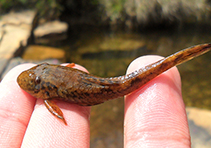| Family: |
Loricariidae (Armored catfishes), subfamily: Hypoptopomatinae |
| Max. size: |
4.74 cm SL (male/unsexed); 4.2 cm SL (female) |
| Environment: |
pelagic; freshwater |
| Distribution: |
South America: Brazil. |
| Diagnosis: |
Dorsal soft rays (total): 7-7; Anal soft rays: 5-5; Vertebrae: 29-29. This species is distinguished from P. carrancas and P. hyptiorhachis by the absence of a postdorsal ridge (vs. presence of a postdorsal ridge); differs from all its congeners, except P. hyptiorhachis, by having less vertebrae, 29 (vs. 30 in P. brachyrhyncha and P. cepta; 31 in P. carrancas and P. rudolphi); differs from P. carrancas, P. hyptiorhachis and P. rudolphi by having teeth with a minute lateral cusp (vs. unicuspid teeth); differs from P. brachyrhyncha and P. hyptiorhachis by having the anterior profile of the head elliptical in dorsal view (vs. rounded); differs from P. brachyrhyncha by having the tip of the snout naked (vs. the tip of the snout completely covered with small odontodes), a lower predorsal length (41.0-44.8 mm SL vs. 45.6-48.9 mm SL), higher number of premaxillary teeth (35-48 vs. 28-36), and higher number of dentary teeth (33-49 vs. 26-36); differs from P. cepta by lacking small plates distributed on the thorax and abdomen (Ref. 100791). |
| Biology: |
This species was collected in a stream with clear water, on bedrock and gravel, and with partially submerged riparian vegetation. Usually, individuals were always found in lotic environments associated with rocks, never in lentic (i.e., pools that formed on stretches of the creek). Some areas of the gallery forest were partially preserved, and penetration of light was scarce. Another species sampled syntopically were Astyanax scabripinnis group and Trichomycterus spp. Also observed were amphibian larvae, spiders, leeches, aquatic insects (Coleoptera; Hemiptera) and larval stages of insects (Diptera; Trichoptera; Megaloptera) (Ref. 100791). |
| IUCN Red List Status: |
Data deficient (DD); Date assessed: 14 December 2020 Ref. (130435)
|
| Threat to humans: |
harmless |
Source and more info: www.fishbase.org. For personal, classroom, and other internal use only. Not for publication.

